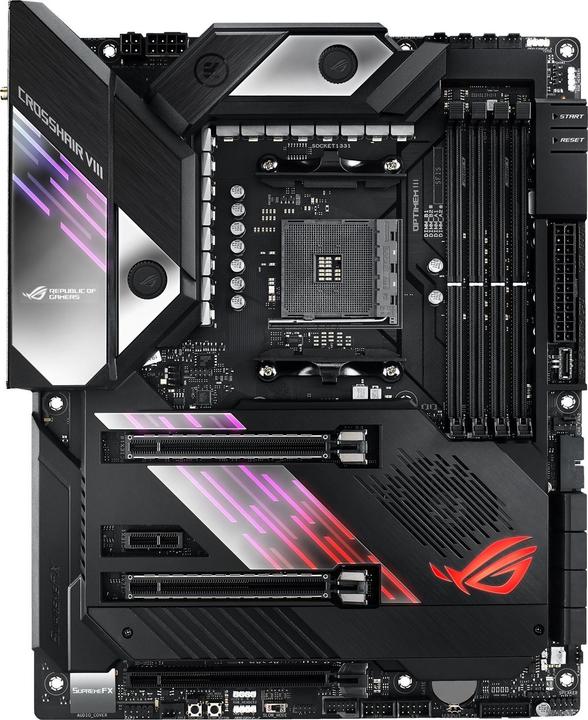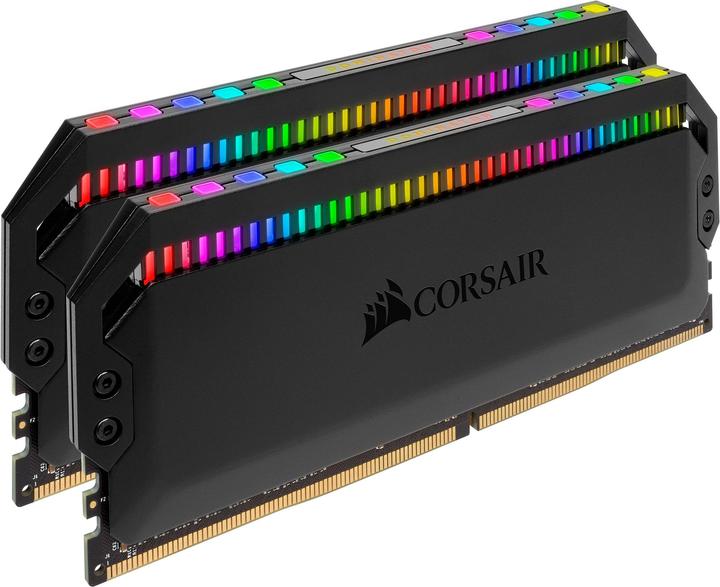

PNY RTX 2060 Super tested: entry-level ray tracing
The RTX 2060 Super is the entry-level ray tracing model. Find out how the model from PNY performs in the test.
The RTX 2060 Super was released on 9 July 2019 - just over half a year after the normal RTX 2060, which it replaces. Although the card is no longer brand new, it is part of Nvidia's current generation of graphics cards. I am currently compiling a database of all current graphics cards so that you can find out which one is right for you right here at digitec.

The card is tested on our DimasTech Easy V3.0 benchtable with the following components:
Facts and features
The 2060 Super has a lot to offer compared to the regular 2060: 13 per cent more CUDA cores and two GB more GDDR6 memory. There are also four more ray tracing cores:
| Nvidia RTX 2060 Super | Nvidia RTX 2060 | |
|---|---|---|
| Chip | TU106 | TU106 |
| CUDA Cores | 2176 | 1920 |
| Texture units | 136 | 120 |
| ROP units | 64 | 48 |
| Base clock | 1470 MHz | 1365 MHz |
| Boost clock | 1650 MHz | 1680 MHz |
| Memory | 8 GB GDDR6 | 6 GB GDDR6 |
| Storage speed | 14 Gbps | 14 Gbps |
| Memory bandwidth (GB/s) | 448 GB/s | 336 GB/s |
| TDP | 175 watts | 160 watts |
The graphics card has two 86-millimetre fans and is 23.5 centimetres long. It is connected to the power supply with an 8-pin PCIe connector. The power consumption is 175 watts. PNY recommends at least a 550 watt power supply unit. The interface is PCI Express 3.0 x16. HDMI, DisplayPort and DVI-D are each available as outputs.

The card is completely black and has a white LED strip on the front.
Synthetic gaming benchmarks, volume and temperatures
Here are the results of the Time Spy and Fire Strike benchmarks:
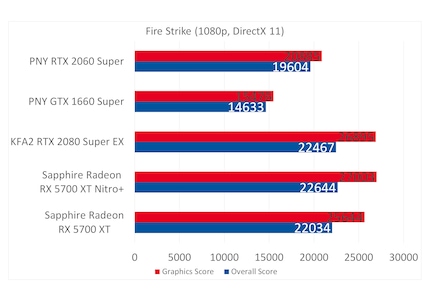
As expected, the 2060 Super ranks ahead of the GTX 1660 Super and behind the Radeon 5700 XT and RTX 2080. Here are the results in tabular form:
| Benchmark | Overall Score | Graphics score and average FPS in Graphics Test 1 and 2 | Combined Score
average FPS |
|---|---|---|---|
| Fire Strike
(1080p, DirectX 11) | 19 604 | 20 885
98.35 / 84.34 | 10 119 |
| Fire Strike Ultra
(2160p, DirectX 11) | 5254 | 5022
26.81 / 18.42 | 2794 |
| Time Spy
(1440p, DirectX 12) | 8800 | 8429
54.4 / 48.76 | n/a |
| Time Spy Extreme
(2160p, DirectX 12) | 4215 | 3963
25.3 / 23.16 | n/a |
In the open test benchmark, the 2060 Super reaches a maximum temperature of 73° Celsius. The temperature is between 66° and 73° Celsius. With the fans on automatic speed, I measured 51 dB from a distance of 30 centimetres with the Testo Sound Level Meter 815 31.5.
With the fans on automatic speed, I measured 51 dB from a distance of 30 centimetres.
When I turn the fans up to 100 per cent via MSI Afterburner, they howl at 60 dB. My colleagues ask me in amazement whether I'm testing a hoover. No, these are the fans of the PNY 2060 Super. Fortunately, they never run at maximum speed in everyday life. In Time Spy, I get a score of 8890 points with the fans fully turned up. That's only one per cent more performance for 9 dB more noise. The card only gets warm between 60° and 64° Celsius.
In order to be able to make a better statement about the cooling performance of the cards, I test them normalised by volume. In MSI Afterburner, I gradually lower the percentage output of the fans until I measure 40 dB from a distance of 30 centimetres. This means the fans are running at 52 per cent of their maximum power. We humans consider 40 dB to be quiet. If I drive Time Spy like this, I achieve a score of 8755 points. That's only half a per cent less than with automatic fan speed. But the card gets all the hotter: I measure between 70° and 77° Celsius.
Application: Puget Systems Photoshop benchmark
The Photoshop benchmark uses the following reference workstation as the basis for calculating the scores:
- Intel Core i9 9900K 8 Core
- NVIDIA GeForce RTX 2080 8GB
- 64GB of RAM
- Samsung 960 Pro 1TB
The results of the reference workstation can be used to estimate how well other systems perform. Our test benchmark with the PNY RTX 2660 Super achieves the following results:
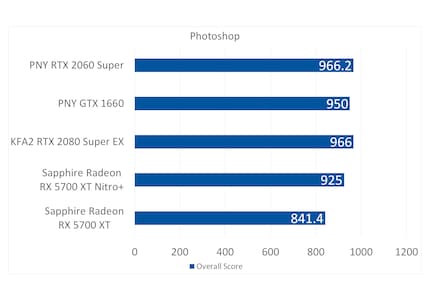
Here are the results in detail:
| Scores | PNY GTX 2060 Super | PNY GTX 1660 Super | Sapphire Radeon RX 5700 XT Nitro+ | KFA2 RTX 2080 Super EX | Reference workstation |
|---|---|---|---|---|---|
| Overall Score | 966.2 | 950 | 925 | 966 | 1000 |
| General Score | 94.4 | 92.9 | 92.5 | 94.4 | 100 |
| Filter Score | 97.3 | 94.5 | 89.8 | 97.3 | 100 |
| Photomerge Score | 99.7 | 100.2 | 97.9 | 99.6 | 100 |
| GPU Score | 97.9 | 93.9 | 90.8 | 100.5 | 100 |
The RTX 2060 Super performs very well. It is at the top of the overall score. It even achieved 0.2 points more than the RTX 2080 Super. The fact that it performs better than the 5700 XT may be due to the fact that Photoshop has now been optimised for the Ryzen 9 3900X. I have already carried out night tests of the RTX 2080 Super and it performed much better than in the original test. It's still amazing how well the 2060 Super performs compared to the 2080 Super. As soon as I get round to it, I'll also do night tests for the 5700 XT. I will provide the updated results in an upcoming graphics card review.
Application: Puget Systems Premiere Benchmark
In contrast to the Photoshop benchmark, our test benchmark does not compete against a reference workstation. With the Premiere benchmark from Puget Systems, the score is calculated relative to the frame rate of the test videos. If the test video has an FPS of 29.97 and the system renders it at 29.97 FPS, this means 100 points. If it is only 14.98 FPS, there are also only 50 points.
The benchmark runs media in the formats 4K H.264 with 150 Mbps in 8 bit (59.94 FPS), 4K ProRes 422 16 bit (59.94 FPS) and 4K RED (59.94 FPS). He tested live playback in Adobe Premiere Pro and the export. A value of 100 is the maximum for live playback, as Premiere cannot play back the media faster than specified. For export, on the other hand, over 100 points are feasible, as rendering is not limited to the FPS of the media.
In addition, ten ProRes 422 clips are provided with effects that place a heavy load on the graphics card. Puget Systems calls this 4K Heavy GPU Effects. These clips are then played back and exported in Premiere. The same exists for Heavy CPU Effects, with effects that place a heavy load on the CPU. The GPU value is particularly relevant for the graphics card reviews. The CPU values are nevertheless listed for the sake of completeness.
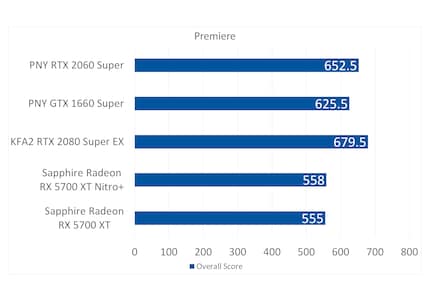
Here are the results in detail:
| Test | PNY RTX 2060 Super | PNY GTX 1660 Super | Sapphire Radeon RX 5700 XT Nitro+ | KFA2 RTX 2080 Super EX |
|---|---|---|---|---|
| Overall Score | 652.5 | 625.5 | 558 | 679.5 |
| Standard Live Playback Score | 66.6 | 63.2 | 52.6 | 69 |
| Export Score | 63.9 | 61.9 | 59 | 66.9 |
| 4K H.264 with 150 Mbps in 8 bit (59.94 FPS) | 56 Live Playback Score
95 Export Score | 56 Live Playback Score
94 Export Score | 57 Live Playback Score
87 Export Score | 57 Live Playback Score
93 Export Score |
| 4K ProRes 422 16 bit (59.94 FPS) | 98 Live Playback Score
96 Export Score | 97 Live Playback Score
96 Export Score | 72 Live Playback Score
93 Export Score | 98 Live Playback Score
96 Export Score |
| 4K RED (59.94 FPS) | 60 Live Playback Score
73 Export Score | 57 Live Playback Score
74 Export Score | 60 Live Playback Score
74 Export Score | 58 Live Playback Score
71 Export Score |
| 4K Heavy GPU Effects | 68 Live Playback Score
35 Export Score | 55 Live Playback Score
25 Export Score | 34 Live Playback Score
26 Export Score | 78 Live Playback Score
51 Export Score |
| 4K Heavy CPU Effects | 51 Live Playback Score
21 Export Score | 51 Live Playback Score
21 Export Score | 46 Live Playback Score
20 Export Score | 51 Live Playback Score
21 Export Score |
So far, Nvidia graphics cards have been faster in Premiere. This also seems to be the case with the Navi cards. The RTX 2060 Super leaves the 5700 XT behind.
Application: Puget Systems after-effects benchmark
In the Puget Systems After Effects benchmark, the benchmark scores are structured similarly to Photoshop. The following reference workstation serves as the basis for calculating the scores:
- Intel Core i9 9900K
- 128 GB RAM
- NVIDIA GeForce RTX 2080 8GB
The results of the reference workstation can be used to estimate how well other systems perform. Our test benchmark with the 2060 Super achieves the following results:
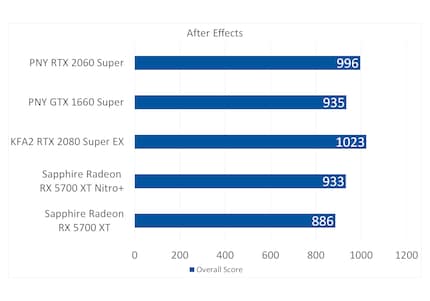
Here are the results in detail:
| Scores | PNY RTX 2060 Super | PNY GTX 1660 Super | Sapphire Radeon RX 5700 XT Nitro+ | KFA2 RTX 2080 Super EX | Reference workstation |
|---|---|---|---|---|---|
| Overall Score | 996 | 935 | 886 | 1023 | 1000 |
| Render Score | 100.5 | 98.6 | 94.1 | 103 | 100 |
| Preview Score | 94.1 | 86.7 | 79.5 | 94.5 | 100 |
| Tracking score | 104.1 | 95.2 | 92.2 | 109.4 | 100 |
In After Effects, the picture is similar to that in Photoshop and Premiere: The 2060 Super leaves the competition from AMD behind and also distances itself from the 1660 Super. The result is very close to the 2080 Super.
Application: Puget Systems benchmark Resolve
The scores of the Resolve benchmark from Puget Systems are also based on a reference workstation. To determine the scores, videos are rendered in 4K using the h.264 codec. The reference workstation is based on the following components:
- Intel Core i9 9900K
- A minimum of 32 GB RAM (not mentioned by Puget Systems)
- NVIDIA Titan RTX 24GB
In the 4K benchmark, I achieve the following results with our test benchmark and the RTX 2060 Super:
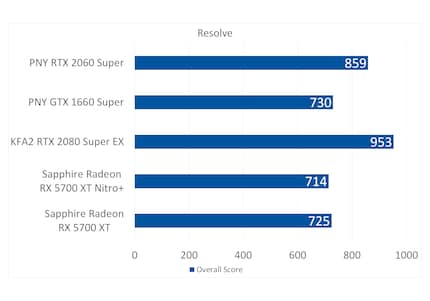
The 2060 Super is positioned between the GTX 1660 Super and the RTX 2080 Super. However, the gap to the 2080 Super is greater than in the Adobe Suite benchmarks.
The results in detail:
| Test | PNY RTX 2060 Super | PNY GTX 1660 Super | Sapphire Radeon RX 5700 XT Nitro+ | KFA2 RTX 2080 Super EX |
|---|---|---|---|---|
| 4K Average Results Overall Score | 859 | 730 | 714 | 953 |
| 4K H264 150 Mbps 8 bit Codec Average Score | 87.2 | 74.5 | 71.1 | 93.6 |
| 4K Cinema Raw Light | 82.2 | 66.1 | 51.9 | 95.9 |
| 4K ProRes 422 | 88.2 | 79 | 71.1 | 96.1 |
| 4K ProRes 4444 | 85.9 | 77.8 | 74.4 | 94.1 |
| 4K RED | 86.1 | 67.4 | 88.4 | 94.1 |
Blender
The Blender benchmark currently has a problem with Nvidia graphics cards on our testbench. Unfortunately it always crashes. That's why I can't provide any results here.
Virtual reality
When it comes to VR, I'm still looking for a programme to test games myself. Unfortunately, Nvidia's FCAT VR doesn't work for us. So here are the results from VRMark and Superposition from Unigine. Please let me know in the comments column if you know of another good tool for benching VR games.
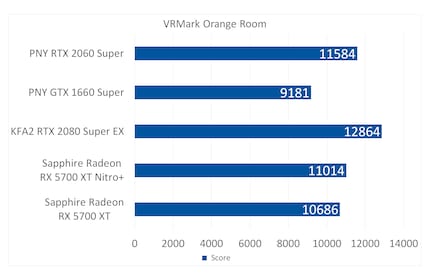
The games
In response to reader feedback, I have revised the Games section. Instead of four games, there are nine games in the test pool. I have completely removed "Crysis 3" and "Control". I have already carried out night tests with the RTX 2080 Super. I will provide results for the 5700X Nitro+ from Sapphire in a later graphics card review.
You can find the graphics of the frametime measurement under this link on the ftp server.

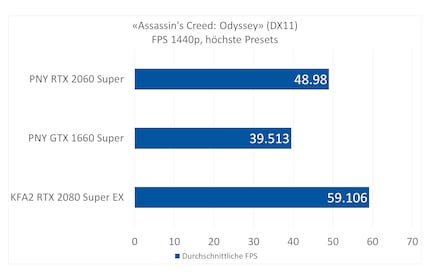
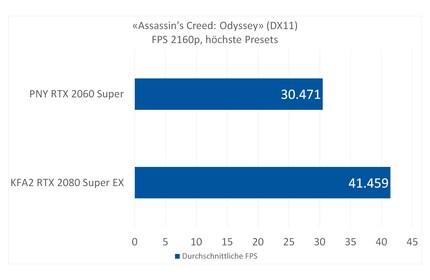

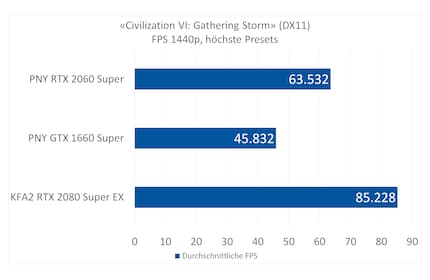
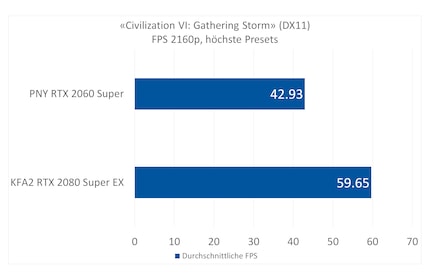

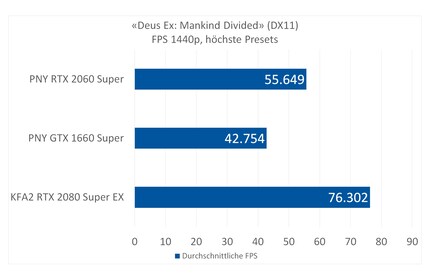

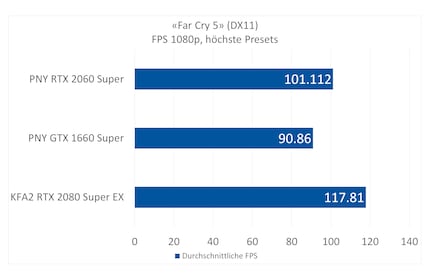
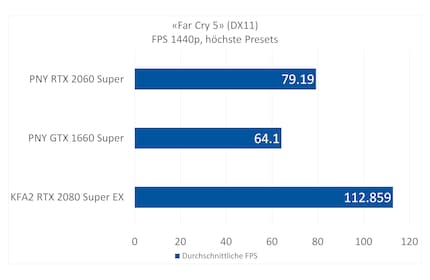


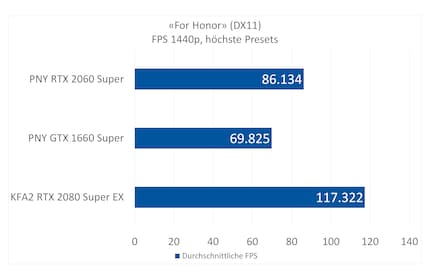
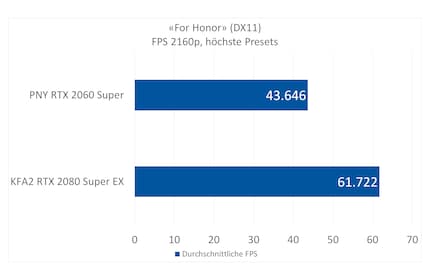

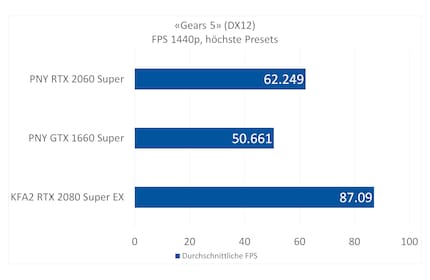
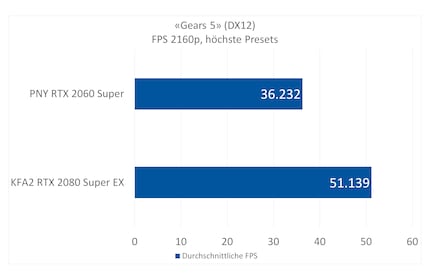
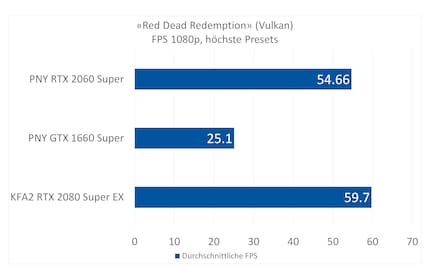
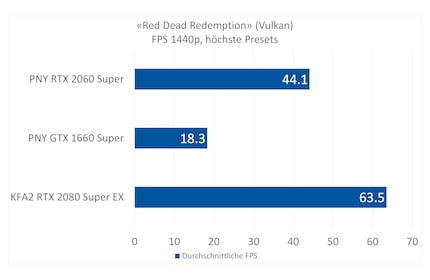
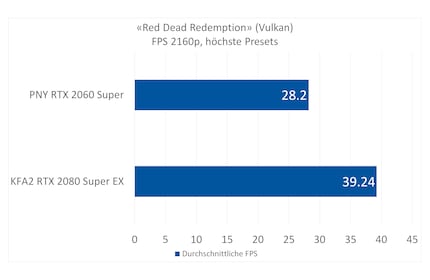
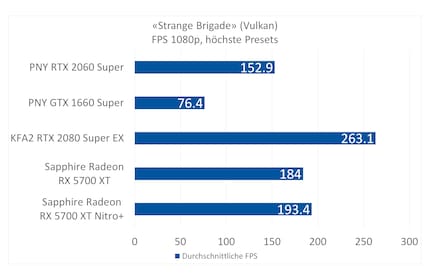
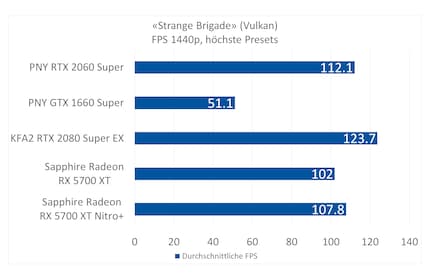
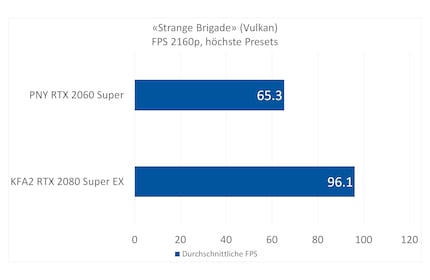
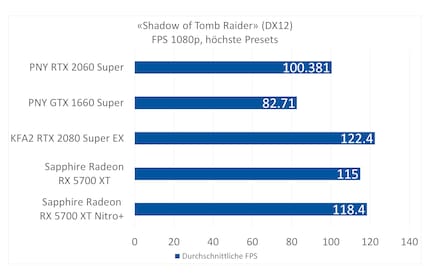
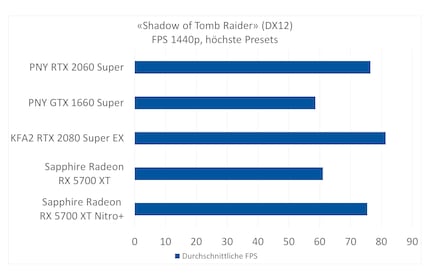
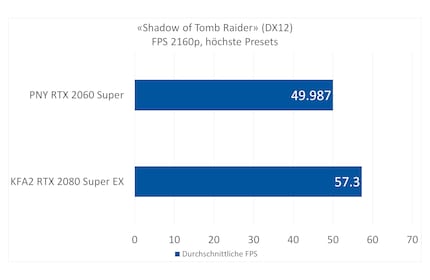
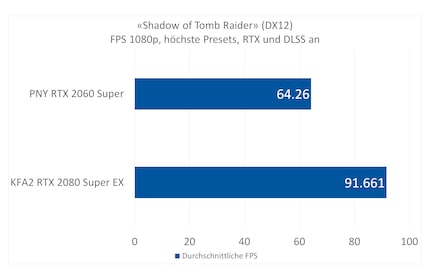

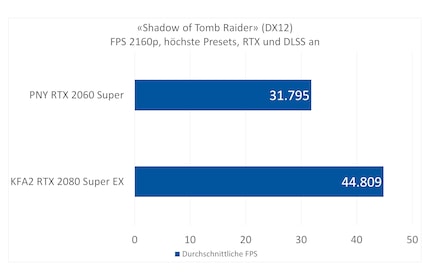
Here are the results in detail:
| Game | **PNY RTX 2060 Super | PNY GTX 1660 Super | Sapphire Radeon RX 5700 XT Nitro+ | KFA2 RTX 2080 Super EX |
|---|---|---|---|---|
| "Assassin's Creed: Odyssey" (DX11) FPS 1080p, highest presets | min. 49, average 59,581, max. 89
average frame time: ms | min. 43, average 50,829, max. 70
average frame time: 19 ms | n/a | min. 54, average 67,061, max. 90
average frame time: ms |
| "Assassin's Creed: Odyssey" (DX11) FPS 1440p, highest presets | min. 41, average 48,980, max. 67
average frame time: ms | min. 34, average 39,513, max. 53
average frame time: 25.2 ms | n/a | min. 49, average 59,106, max. 78
average frame time: ms |
| "Assassin's Creed: Odyssey" (DX11) FPS 2160p, highest presets | min. 24, average 30,471, max. 42
average frame time: ms | n/a | n/a | min. 35, average 41,459, max. 69
average frame time: ms |
| "Civilisation VI: Gathering Storm" (DX11) FPS 1080p, highest presets | min. 62, average 79,493, max. 108
average frame time: ms | min. 49, average 60,553, max. 91
average frame time: 16.8 ms | n/a | min. 65, average 91,165, max. 132
average frame time: ms |
| "Civilisation VI: Gathering Storm" (DX11) FPS 1440p, highest presets | min. 52, average 63,532, max. 82
average frame time: ms | min. 39, average 45,832, max. 58
average frame time: 22.4 ms | n/a | min. 71, average 85,228, max. 113
average frame time: ms |
| "Civilisation VI: Gathering Storm" (DX11) FPS 2160p, highest presets | min. 34, average 42,930, max. 52
average frame time: ms | n/a | n/a | min. 48, average 59,650, max. 71
average frame time: ms |
| "Deus Ex: Mankind Divided" (DX11) FPS 1080p, highest presets | min. 43, average 79,659, max. 105
average frame time: ms | min. 41, average 60,851, max. 79
average frame time: 16.3 ms | n/a | min. 70, average 104,221, max. 138
average frame time: ms |
| "Deus Ex: Mankind Divided" (DX11) FPS 1440p, highest presets | min. 38, average 55,649, max. 71
average frame time: ms | min. 31, average 42,754, max. 55
average frame time: 23 ms | n/a | min. 52, average 76,302, max. 99
average frame time: ms |
| "Deus Ex: Mankind Divided" (DX11) FPS 2160p, highest presets | min. 24, average 30,422, max. 39
average frame time: ms | n/a | n/a | min. 33, average 43,559, max. 55
average frame time: ms |
| "Far Cry 5" (DX11) FPS 1080p, highest presets | min. 77, average 101,112, max. 123
average frame time: ms | min. 58, average 90.86, max. 104
average frame time: 11.2 ms | n/a | min. 52, average 117,810, max. 158
average frame time: ms |
| "Far Cry 5" (DX11) FPS 1440p, highest presets | min. 67, average 79,190, max. 92
average frame time: ms | min. 56, average 64,099, max. 75
average frame time: 15.8 ms | n/a | min. 91, average 112,859, max. 139
average frame time: ms |
| "Far Cry 5" (DX11) FPS 2160p, highest presets | min. 36, average 43,358, max. 52
average frame time: ms | n/a | n/a | min. 56, average 67,638, max. 78
average frame time: ms |
| "For Honor" (DX11) FPS 1080p, highest presets | min. 57, average 130,460, max. 168
average frame time: ms | min. 49, average 102.685, max. 9.78
average frame time: 15.8 ms | n/a | min. 50, average 173,266, max. 226
average frame time: ms |
| "For Honor" (DX11) FPS 1440p, highest presets | min. 56, average 86,134, max. 111
average frame time: ms | min. 53, average 69.825, max. 86
average frame time: 14.4 ms | n/a | min. 49, average 117,322, max. 154
average frame time: ms |
| "For Honor" (DX11) FPS 2160p, highest presets | min. 32, average 43,646, max. 56
average frame time: ms | n/a | n/a | min. 46, average 61,722, max. 81
average frame time: ms |
| "Gears 5" (DX12) FPS 1080p, highest presets | min. 67, average 86,034, max. 109
average frame time: ms | min. 51, average 78,777, max. 84
average frame time: 15 ms | n/a | min. 62, average 102,843, max. 117
average frame time: ms |
| "Gears 5" (DX12) FPS 1440p, highest presets | min. 50, average 64,249, max. 80
average frame time: ms | min. 26, average 50,661, max. 86
average frame time: 20.4 ms | n/a | min. 69, average 87,090, max. 105
average frame time: ms |
| "Gears 5" (DX12) FPS 2160p, highest presets | min. 29, average 36,232, max. 47
average frame time: ms | n/a | n/a | min. 42, average 51,139, max. 62
average frame time: ms |
| "Red Dead Redemption" (Vulkan) FPS 1080p, highest presets | min. 35.5, average 54.6, max. 85.9
average frame time: n/a | min. 19.816, average 25.1049, max. 30.6963
average frame time: n/a | n/a | min. 41.9, average 59.7, max. 80.2
average frame time: n/a |
| "Red Dead Redemption" (Vulkan) FPS 1440p, highest presets | min. 30.2, average 44.1, max. 63.5
average frame time: n/a | min. 14.9966, average 18.3357, max. 22.2369
average frame time: n/a | n/a | min. 30.2, average 63.5, max. 44.1
average frame time: n/a |
| "Red Dead Redemption" (Vulkan) FPS 2160p, highest presets | min. 21.6, average 28.2, max. 39.3
average frame time: n/a | n/a | n/a | min. 29.8, average 39.24, max. 51.2
average frame time: ms |
| "Shadow of Tomb Raider" (DX12) FPS 1080p, highest presets | min. 2, average 100.4, max. 158
average frame time: ms | min. 3, average 82,717, max. 322
average frame time: 12.8 ms | min. 94, average 118.4, max. 168
average frame time: 9.5 ms | min. 96.4, average 122.4, max. 180.4
Frametime: 7-9 ms |
| "Shadow of Tomb Raider" (DX12) FPS 1440p, highest presets | min. 2, average 76.4, max. 115
average frame time: ms | min. 0, average 58,621, max. 417
average frame time: 18.3 ms | min. 43, average 75.4, max. 87.8
average frame time: 16.2 ms | min. 63.2, average 81.4, max. 97.4
Frametime: 14-16 ms |
| "Shadow of Tomb Raider" (DX12) FPS 2160p, highest presets | min. 2, average 49,987, max. 139
average frame time: ms | n/a | n/a | min. 50.2, average 57.3, max. 68.7
Frametime: 17-19 ms |
| "Shadow of Tomb Raider" (DX12) FPS 1080p, highest presets, RTX and DLSS on (max.) | min. 0, average 64.2, max. 122
average frame time: ms | n/a | n/a | min. 24, average 91,661, max. 172
Frametime: 10.9 ms |
| "Shadow of Tomb Raider" (DX12) FPS 1440p, highest presets, RTX and DLSS on (max.) | min. 0, average 49,031, max. 113
average frame time: ms | n/a | n/a | min. 29, average 69,285, max. 123
Frametime: 14.4 ms |
| "Shadow of Tomb Raider" (DX12) FPS 2160p, highest presets, RTX and DLSS on (max.) | min. 0, average 31,795, max. 134
average frame time: ms | n/a | n/a | min. 28, average 44,809, max. 72
Frametime: 22.2 ms |
| "Strange Brigade" (Vulkan) FPS 1080p, highest presets | min. 112.2, average 152.9, max. 213.6
average frame time: 6.54 ms | min. 59.9, average 76.6, max. 103.9
average frame time: 13.096 ms | min. 120, average 193.4, max. 297.9
average frame time: 6.77 ms | min. 177.5, average 263.1, max. 311.7
Frametime: 4-6 ms |
| "Strange Brigade" (Vulkan) FPS 1440p, highest presets | min. 88.4, average 112.1, max. 150.3
average frame time: 8.92 ms | min. 42.2, average 51.1, max. 67.7
average frame time: 19,563 ms | min. 74, average 107.8, max. 221.7
average frame time: 10.3 ms | min. 108.4, average 123.7, max. 147.8
Frametime: 7-9 ms |
| "Strange Brigade" (Vulkan) FPS 2160p, highest presets | min. 55.4, average 65.3, max. 83.8
average frame time: 15.3 ms | n/a | n/a | min. 84.8, average 96.1, max 114.8
Frametime 10-12 ms |
Conclusion: A 2060 Super is also sufficient for the Adobe Suite
In the synthetic benchmarks, the PNY 2060 Super ranks where the price suggests: in the midfield. The card can be very loud at up to 60 dB. When gaming and in the synthetic benchmarks, it is 51 dB. That's okay, but it's not whisper-quiet either. The card gets relatively warm at up to 73° Celsius. The 2080 Super from KFA2, which actually runs hotter, only reached a maximum temperature of 67° Celsius thanks to the cooling.
The 2060 Super performs superbly in the Adobe Suite benchmarks. In Premiere, the card is four per cent slower than the 2080 Super and in After Effects only around 3 per cent. In Photoshop, the cards are on a par. The difference is negligible when you consider that a 2080 Super costs over 50 per cent more than a 2060 Super. In Da Vinci Resolve, however, a 2080 Super is more profitable than a 2060 Super.
The card shows its full qualities when gaming at 1080p. In 1440p you have to turn the quality down a little in certain games. Thanks to DLSS, "Shadow of the Tomb Raider" can also be played with high ray tracing settings. For a higher frame rate, however, you'll have to make do with 1080p.
At 405 francs (as of 4.3.20), the PNY 2060 Super is in the lower price segment of the 2060 Super cards. It therefore offers an "affordable" introduction to ray tracing. If I compare the card with the previously tested 1660 Super from PNY, the price for the performance difference and ray tracing is justified.
From big data to big brother, Cyborgs to Sci-Fi. All aspects of technology and society fascinate me.
